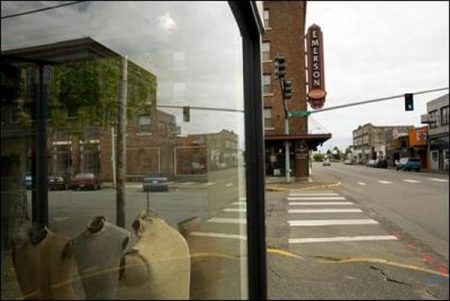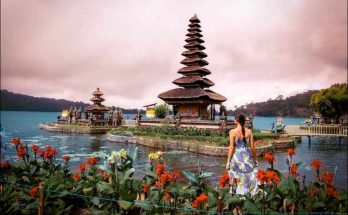Aberdeen and Hoquiam, originally settlements four miles apart, have grown into a single population center, divided only by Myrtle Street. In an atmosphere hazy with smoke from mill stacks and burners, these twin cities spread along Grays Harbor and the tidal waters of the three rivers flowing into it: Aberdeen lies at the confluence of the Chehalis and the Wishkah Rivers; Hoquiam borders the banks of the Hoquiam River.
Both cities face Grays Harbor, whose entrance, 12 miles westward, is often blanketed by the fog or rainfall characteristic of the region. The industrial area of both cities stretches along the water front. Here are numerous sawmills, with their sheds, yards, and loading docks. Stacks of freshly cut lumber diffuse through the streets the pungent odor of fir cedar, and hemlock. Straddle-legged lumber carriers, motor driven, roll swiftly about the yards. Large cranes swing arms laden with lumber from the yard to the deck of a ship berthed against the wharf.
From the mill comes the shrill whine of high-speed saws and the muffled thunder of a huge log as it is hurled about on a rushing saw-carriage by the iron kick of the mechanical “nigger.” Over the acres of roofs covering mills and woodworking plants, jets of live steam escape in white plumes, and here and there a tall stack pencils a drifting pattern of smoke against the sky.
Together, Aberdeen and Hoquiam were born of lumber, and through it chiefly have they lived. Aberdeen, the larger of the cities, with compact blocks of substantial office buildings, stores, hotels, garages, and theaters along Wishkah Street, the main thoroughfare, has the appearance of a small metropolis. North of the business section, the terrain rises to the higher ground of the residential area until it reaches the heights of Bel-Aire, which, with its fine homes, is the social as well as the topographic apex of the city. Here a panoramic view of the city and Grays Harbor may be had, with Chehalis Point Lighthouse at the entrance, and a glimpse of the rolling Pacific to the west.
On the border of the planked streets fringing the mills and factories, are “crackerbox” buildings whose shoddy rooming houses, pool halls, beer parlors, and shops cater to workingmen. In East and South Aberdeen, where most of the mill workers live, national origins are reflected in the Swedish cottages and in the octagonal-shaped Finnish houses with their many windows. Here, too, still stand a few old farmhouses, with soot-encrusted shingles and weather-beaten sides.
Hoquiam, reached through Aberdeen, is situated on deep water at the mouth of the Hoquiam River, 12 miles from the Pacific Ocean. Pioneer settlement of the Grays Harbor region, it is the elder of the two cities. In economy, industrial development, and general character, it is much like its sister city. West of the river the streets, starting at the water front, run diagonally through the business area until they join with the east-west avenues. To the north is a residential area, dominated by Hoquiam Heights. East of the river, streets run from the flats of the water front up to the heights of Campbell Hill.
The two cities have separate municipal governments, but, since they act jointly in many administrative matters, and are so largely interdependent industrially and socially, it has become difficult to speak of one without mentioning the other. Together, they represent the culture and industry of the Grays Harbor district, a territory which, walled in by one of the heaviest stands of timber in the Pacific Northwest, by mountains and hills on three sides, and by the Pacific Ocean on its entire western length, was once almost unapproachable except by water.
Views: 195



